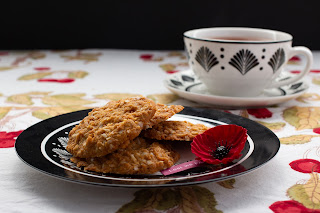Gluten free ANZAC biscuits
History is often written by the victorious, predominantly by men. The voices of women, minorities and others are frequently missing from official narratives, or at best given fleeting recognition.
ANZAC Day falls on the 25th of April, commemorating the landing of Australian and New Zealand troops at Gallipoli in 1915, during the Great War. In both Australia and New Zealand, this public holiday honours all servicemen and women who have served in war and peacekeeping operations. The day begins with a solemn dawn service, followed by parades of returned servicemen and women, and community celebrations filled with pride. The Gallipoli landing is often referred to as "the birth of our nation". It's a decidedly masculine view of birth, but the sacrifice made by so many is one for which I am eternally grateful.
The story of the ANZAC biscuit showcases the resilience of women. These women bid farewell to the troop ships heading across to the other side of the world. It was a time of slow communication - by telegram or mail transported by ship. Telephones were far from common in homes, let alone in most pockets, and the arrival of a telegram was often dreaded, as it frequently brought bad news.
Edmonds, a classic New Zealand cookbook first published in 1908, is similar in spirit to the Australian Women's Weekly or The Country Women's Association cookbooks. In my copy, gifted to me by my lovely Kiwi friend, Cara, there's a brief history of these biscuits, originally known as "Soldiers' Biscuits". Concerned about the nutritional value of the food supplied to their men, the wives, mothers and girlfriends sought solutions. Any food they sent to the fighting men had to be carried in the non-refrigerated ships of the Merchant Navy and remain edible for two months. These inventive women took a Scottish oats biscuit recipe and adapted it. Adding to the challenge, most poultry farmers had enlisted in the armed services, and eggs were scarce. Consequently, golden syrup or treacle was used as the binding agent.
By WWII, refrigeration had improved, and women could send other treats, such as fruit cake, to the men away fighting. My grandfather, Arthur Thyne, served in the 2/24th Australian Infantry Battalion, which saw extensive service at Tobruk, Libya, manning the Red Line and participating in the intense fighting in the Salient.
In this recipe, bicarbonate of soda is used to lend some lightness to these biscuits. When combined with an acid, such as lemon juice or yoghurt, bicarbonate of soda releases carbon dioxide, creating a rapid reaction perfect for pancakes or muffins. Here, the bicarb reacts to the temperature above 80°C and releases carbon dioxide, creating a foaming mixture added to the dry ingredients. Only half the carbon dioxide is released in this reaction, which can result in a slightly soapy taste but also contributes to the golden yellow colour of the end result. This is why we use only a small amount of bicarb in this recipe.
Regrettably, oats are not gluten-free, as per Coeliac Australia guidelines. Thankfully, quinoa flakes offer a similar texture and a delightful nutty taste. To compare the two, quinoa and oats have similar kilojoule and protein content per 100g, with less fat in quinoa, fewer carbohydrates in oats, and just over four times more fibre in oats.
The ANZAC biscuit tradition lives on and these biscuits remain a favourite in our family. The CWA continues today to make and sell these delicious and symbolically potent biscuits, celebrating the bravery of men and the ingenuity of women.
Makes 24
• 120 g butter
• 2 tbl golden syrup
• 1/2 tsp bicarbonate soda
• 2 tbl boiling water
• 80 g quinoa flakes
• 100 g castor sugar
• 150 g GF plain flour
• 60 g shredded coconut
Preheat oven to 130°C.
Combine butter and golden syrup in a small saucepan. Stir over heat until butter is melted.
In a separate bowl, combine bicarbonate soda and boiling water. Stir into butter mixture.
Combine all dry ingredients in a large bowl. Add butter mixture and mix well.
Drop rounded teaspoons of mixture about 4 cm apart on lined oven trays, and lightly press.
Bake in the middle of the oven, for 20 minutes or until slightly brown.
Cool on trays.
Updated July 2023




Comments